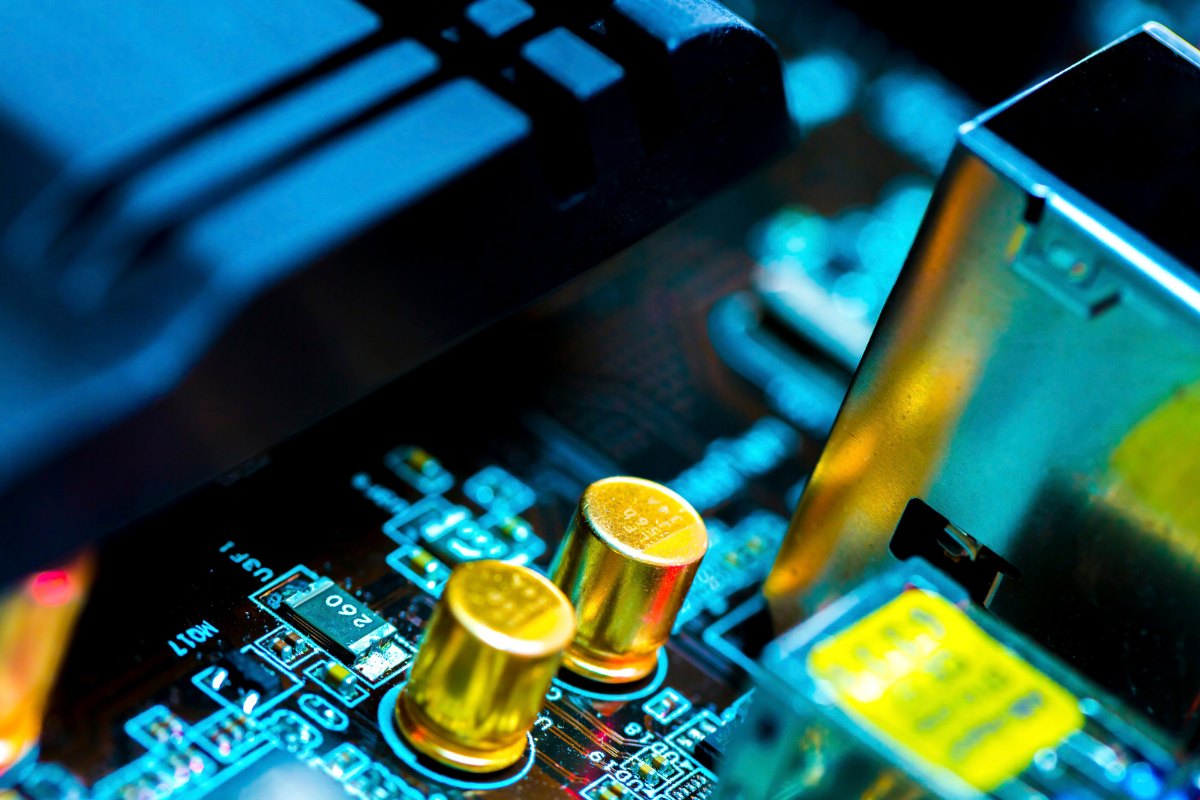전자 제품에 관심이 있다면 전자 회로가 어떻게 작동하는지 궁금할 것입니다. 회로는 기본적으로 우리가 생각할 수 있는 모든 전자 기기의 구성 요소입니다. 회로가 없으면 전류가 다른 장치의 개별 전자 부품을 통과할 수 있는 수단이 없습니다.
전자 회로는 일반적으로 저항기, 트랜지스터, 커패시터와 같은 다양한 전자 부품으로 구성됩니다. 이러한 개별 부품 간의 연결은 전기가 흐르도록 하는 전선 또는 트레이스를 사용하여 이루어집니다. 회로의 작동은 여러 요소의 조합에 따라 기본적이거나 복잡할 수 있습니다.
오늘날 회로는 일반적으로 인쇄 기판에서 볼 수 있으며, 다양한 윤곽선 조각을 기판에 납땜하여 부품을 상호 연결하여 최종 제품을 만듭니다.
회로 구성 요소
앞서 언급했듯이 전자 회로는 일반적으로 저항기, 트랜지스터, 커패시터와 같은 다양한 전자 부품으로 구성됩니다.
저항기
저항기는 전자 회로의 기본 구성 요소입니다. 저항은 전기 회로에 저항을 도입하여 전류의 흐름을 제어하는 수동 장치입니다. 저항의 단위는 옴(Ω)입니다.
저항기에는 다양한 유형이 있지만 전류 흐름을 제어하는 기본 기능은 모두 동일합니다. 저항의 값은 일반적으로 색상 코드 시스템을 사용하여 본체에 표시되어 있습니다.
저항은 회로에서 다양한 용도로 사용할 수 있습니다. 예를 들어 신호 레벨을 조정하고, 전압을 나누고, 연산 증폭기 게인을 설정하는 데 사용할 수 있습니다. 또한 필터 및 오실레이터와 같이 시간에 따라 작동하는 회로에서 중요한 역할을 합니다.
커패시터
커패시터는 전자 회로에 사용되는 또 다른 유형의 수동 부품입니다. 커패시터는 회로에서 전기 에너지를 저장하고 방출합니다. 커패시턴스의 단위는 패럿(F)이지만 전자제품에 사용되는 대부분의 커패시터는 마이크로패럿(µF), 나노패럿(nF) 또는 피코패럿(pF) 범위의 커패시턴스 값을 갖습니다.
커패시터는 유전체라고 하는 절연 재료로 분리된 두 개의 전도성 플레이트로 구성됩니다. 플레이트에 전압이 가해지면 유전체에 전기장이 생성되어 양전하와 음전하가 플레이트에 모이게 됩니다. 이렇게 저장된 전하를 필요할 때 다시 회로로 방출할 수 있습니다.
커패시터는 일반적으로 전원 공급 장치에서 노이즈를 제거하는 필터링 애플리케이션에 사용됩니다. 또한 타이밍 회로, 아날로그 이퀄라이저 및 기타 여러 애플리케이션에도 사용됩니다.
트랜지스터
트랜지스터는 신호를 증폭하거나 스위치 역할을 할 수 있는 능동 부품입니다. 트랜지스터는 현대 전자 기기의 기본 구성 요소입니다. 트랜지스터는 반도체 물질의 세 층으로 이루어져 있으며, 두 개의 n형 층과 그 사이에 p형 층이 있는 경우(npn 트랜지스터) 또는 두 개의 p형 층과 그 사이에 n형 층이 있는 경우(pnp 트랜지스터) 중 하나를 선택할 수 있습니다.
세 개의 층은 트랜지스터에서 두 개의 pn 접합을 형성하며, 트랜지스터가 증폭기 또는 스위치로 작동할 수 있는 것은 이러한 접합 간의 상호 작용입니다. 트랜지스터의 세 부분을 이미터, 베이스, 컬렉터라고 합니다.
트랜지스터는 증폭기, 발진기, 디지털 스위치 등 다양한 회로와 장치에 사용할 수 있습니다. 트랜지스터는 아날로그 회로와 디지털 회로 모두에서 중요한 구성 요소입니다.
회로 유형
회로는 아날로그 회로, 디지털 회로, 혼합 신호 회로의 세 가지 형태로 분류할 수 있습니다.
아날로그 회로
이것은 원래의 형태로 에너지를 사용하는 일종의 회로입니다. 부품 간의 연결이 기호(전선은 선으로 표시되고 다른 전자 부품은 특정 엠블럼에 해당)로 표시되는 전자 회로 다이어그램으로 가장 잘 구현할 수 있습니다.
아날로그 회로의 경우 병렬 회로와 직렬 회로의 두 가지 기본 구조가 있습니다.
- 병렬 연결에서는 모든 전자 부품이 동일한 에너지원에 연결됩니다. 회로의 개별 구성 요소를 통과하는 전류는 특정 저항에 따라 각 부품으로 나뉩니다.
- 직렬 회로에서 개별 구성 요소는 단일 부품에서 사용하는 전류가 다른 모든 부품에서 사용되는 방식으로 서로 연결됩니다. 이와 관련하여 부품 중 하나에 고장이 발생하면 전체가 오작동하게 됩니다.
디지털 회로
이러한 유형의 연결에서는 에너지가 샘플로 처리됩니다. 즉, 신호가 논리 및 숫자 대응의 표현으로 장치에서 수신됩니다. 이 경우 정보는 처리되어 이진 코드의 형태를 취합니다. 디지털 회로는 아날로그 회로보다 설계하기가 훨씬 쉽습니다.
혼합 신호 회로
이것은 아날로그 회로와 디지털 회로를 모두 사용하는 회로의 한 형태입니다. 다양한 유용성을 달성하기 위해 두 신호를 혼합하여 사용합니다. 대부분의 장치에서 아날로그 회로는 신호를 강화하는 데 사용되어 디지털 코드로 변환할 수 있도록 준비합니다.
회로 다이어그램
반면 회로도는 전기 흐름의 지도를 제공합니다. 회로도는 전자 장치에서 전류가 어떻게 연속적으로 흐르는지 파악할 수 있는 수단으로, 전자 장치가 어떻게 작동하는지 시각화할 수 있게 해줍니다.
이 표현을 만드는 주된 이유는 전기 부품과 이를 연결하는 전선 및 경로에 대한 개요를 제공하기 위해서입니다. 회로도를 사용하면 전자 장치를 편리하게 수리할 수 있습니다. 또한 자신이 무엇을 하고 있는지 알고 있는 경우 믿을 수 없을 정도로 빠른 속도로 기기 문제를 해결할 수 있는 충분한 시간을 제공합니다.
일상 속 회로
전자 회로는 일상 생활의 일부입니다. 평소에는 잘 느끼지 못하지만, 이러한 연결이 있어야만 사용할 수 있는 기기들이 많이 있습니다. 우리가 매일 사용하는 다양한 기기에 탑재된 신뢰할 수 있는 회로 덕분에 생활의 많은 편리함을 경험하고 있습니다.
회로가 없는 삶을 상상해 보면 회로가 얼마나 중요한지 확실히 깨닫게 될 것입니다. 이러한 전기적 연결이 없다면 삶은 좀 더 복잡하고 후퇴할 것입니다. 전자제품을 이해하는 것이 자신의 특기는 아닐지 모르지만, 회로가 작동하는 데 어떻게 기여하는지 알면 호기심이 해소되고 전자 기기의 작동 원리를 더 잘 이해할 수 있습니다.
전자 회로의 미래
기술이 계속 발전함에 따라 전자 회로는 점점 더 작아지고 복잡해지고 있습니다. 이로 인해 하나의 칩에 수천 개 또는 수백만 개의 트랜지스터가 포함된 집적 회로가 개발되었습니다. 이러한 발전 덕분에 더 강력하고 효율적인 전자 기기를 만들 수 있게 되었습니다.
미래에는 전자 회로 기술이 더욱 발전할 것으로 예상됩니다. 여기에는 전자 분야에 혁명을 일으키고 놀랍도록 강력한 양자 컴퓨터의 탄생으로 이어질 수 있는 양자 회로의 개발이 포함될 수 있습니다.
결론
전자 회로를 이해하는 것은 전자 제품에 관심이 있는 모든 사람에게 필수적입니다. 자신만의 장치를 만들려는 취미 생활자든 전문 엔지니어든, 회로의 작동 원리를 제대로 이해하면 더 효과적이고 효율적인 전자 장치를 만들 수 있습니다. 따라서 다음에 전자 기기를 사용할 때는 잠시 시간을 내어 그 기기를 작동시키는 복잡한 회로망에 대해 알아보세요.
